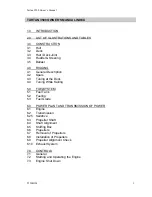
2. OPERATING THE BOAT
__PAGE 13
NOTE
WARNING
or challenging water and weather conditions. When running with a very high
bow (typically when accelerating from non-planing to planing speed), the view
may be partially obstructed. If so, ask a passenger for assistance with view or
stand up if it helps you to see better. Minimize the time under such conditions.
Always adjust the speed and trim to the prevailing conditions. Be particularly
careful when driving at high speeds and waves. For instance, a low bow in high
waves or in a tailwind may cause the bow to plunge into waves and fill the boat
with water, or may cause sharp and sudden direction changes.
Sharp turns, a too low bow or sideways waves at high speeds may be very
dangerous due to the risk of fast changes of directions causing passengers and
the operator to shift and loose grip, potentially be hurt and/or lose control of
the boat.
1. Adjust the engine trim with care – at high speed it significantly changes the behavior of the
craft. Do not operate this craft with engine trim at negative angles (boat bow pushed
down) at high speeds. Craft may lean over on side or dive/plunge into waves. Instability in
turns may result.
2. Waves impair handling. Reduce the speed in rough seas.
3. Do not operate at high speed while in congested high traffic water ways or in weather
and sea condition of reduced visibility, high winds or large waves. Observe and obey
speed limit and no wake zones.
4. Handling is impaired as speed increases. Rapid turns can lead to loss of control. Slow
down before sharp turns in either direction. Avoid rapid movements while driving at high
speeds, in high waves and at strong winds.
5. Never operate the boat if the engine rated power exceeds the maximum recommended
power.
6. Do not sit in the bow area (in front of consoles) when the boat is moving at speeds
higher than approximately 10 knots, or in conditions with high waves. Sudden boat
movements may cause injuries.
7. Always use the Emergency Engine Shutdown Switch when operating the boat.
1. Ensure sufficient seamanship and operator training as mentioned in introduction, as this
book is not a training book for good seamanship.
2. The International Regulations for Preventing Collisions at Sea (COLREG) and national
regulations requires a proper lookout be maintained at all times and observance of right
of way be respected. Always be certain to have sufficient distance to stop or steer if
required to avoid collisions.
Summary of Contents for B18 Series
Page 1: ...B18 AL CC DC OWNER S MANUAL...
Page 2: ......
Page 4: ......
Page 8: ......
Page 10: ...WELCOME ABOARD __PAGE 2...
Page 62: ...8 ATTACHMENTS__PAGE 54...
Page 63: ......
















































